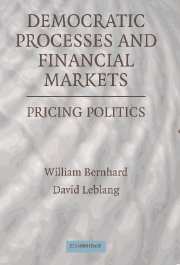Book contents
- Frontmatter
- Contents
- Acknowledgments
- 1 Introduction
- 2 Democratic Processes and Political Risk: Evidence from Foreign Exchange Markets
- 3 When Markets Party: Stocks, Bonds, and Cabinet Formations
- 4 The Cross-National Financial Consequences of Political Predictability
- 5 Cabinet Dissolutions and Interest Rate Behavior
- 6 Bargaining and Bonds: The Process of Coalition Formation and the Market for Government Debt in Austria and New Zealand
- 7 Time, Shares, and Florida: The 2000 Presidential Election and Stock Market Volatility
- 8 Polls and Pounds: Exchange Rate Behavior and Public Opinion in Britain
- 9 Conclusion: Political Predictability and Financial Market Behavior
- References
- Index
7 - Time, Shares, and Florida: The 2000 Presidential Election and Stock Market Volatility
Published online by Cambridge University Press: 02 December 2009
- Frontmatter
- Contents
- Acknowledgments
- 1 Introduction
- 2 Democratic Processes and Political Risk: Evidence from Foreign Exchange Markets
- 3 When Markets Party: Stocks, Bonds, and Cabinet Formations
- 4 The Cross-National Financial Consequences of Political Predictability
- 5 Cabinet Dissolutions and Interest Rate Behavior
- 6 Bargaining and Bonds: The Process of Coalition Formation and the Market for Government Debt in Austria and New Zealand
- 7 Time, Shares, and Florida: The 2000 Presidential Election and Stock Market Volatility
- 8 Polls and Pounds: Exchange Rate Behavior and Public Opinion in Britain
- 9 Conclusion: Political Predictability and Financial Market Behavior
- References
- Index
Summary
Modern presidential elections tend to be predictable: the winner is known long before election day. With the combination of lop-sided vote totals and sophisticated voter surveys, television news reports can confidently predict a winner even before polls close on the west coast. The 2000 contest between the Democratic candidate, Vice President Al Gore, and Republican George Bush, Governor of Texas, however, did not conform to this pattern. Throughout the campaign, polls had the candidates running close. The unpredictability of the race made markets jittery. One portfolio manager commented, “The election is so important and the outcome is so unknown and the effect of it is so unknown that things are on knife edges out there.” Despite the closeness of the race, most Americans assumed that they would quickly learn the identity of the next president on the evening of November 7th, thanks to the wonders of exit polling. But the actual vote totals were so close that television analysts could not conclude who would win the majority of electoral college votes. Indeed, the news anchors were embarrassed when, after calling Florida as a Gore state early in the evening, they had to switch their call, classifying it as a toss-up an hour later. The media then called Florida for Bush later in the night, prompting Gore to call Bush to concede. But a few hours later, it was still not certain how Florida would vote, and news organizations took Florida out of the Bush column. Gore called Bush back.
- Type
- Chapter
- Information
- Democratic Processes and Financial MarketsPricing Politics, pp. 170 - 197Publisher: Cambridge University PressPrint publication year: 2006



